A Short Intro: Tropical Rainforests (and why you should give a damn)
Dear Steemit friends, I am on my way to my 2nd month of being a member here on Steemit and I have learned a lot through the things you shared, particularly about cryptocurrencies, some basic coding, economics, photography, travel, and many others. Speaking of sharing quality contents, I appreciate @steemstem’s and its members’ efforts in promoting the STEM (~Science, Technology, Engineering and Mathematics) fields in order to combat fake facts, and at the same time, show how awesome the human race is in achieving milestones for the advancement of our civilization. But such achievements came at the cost of Earth's different natural ecosystems, even going as far as impacting the climate of our planet. I understand that people are concerned about “climate change”, but climate change itself is the result of many underlying problems.
So, in a bid to help promote awareness, I will do introduction write-ups about the different natural ecosystems. It would not be a very basic introduction, everyone of us have taken biology class at some point. And I would mainly focus more on tropical ecosystems, so I encourage those who are knowledgeable about the ecosystems about the other climatic regions to share their knowledge too. I have chosen to do it in mixed feature and synthesis writing format to give full recognition to the authors who dedicated their lives in their research while not being too technical. Hopefully with this introduction series, people would appreciate these ecosystems more, and the invaluable ecosystem services they provide.
The most unique feature of Earth is the existence of life, and the most extraordinary feature of life is its diversity.
Cardinale et al., 2012
Tropical rainforests are truly marvelous. Of all the terrestrial (land-based) ecosystems, it is the most diverse and maintains a very high biomass production (read below about net annual productivity). Sadly, the majority of the tropical rainforests have been significantly reduced and are continually to be threatened due to their rich resources. It is no wonder why concerned international conservation agencies have put special emphasis on tropical rainforests (Osborne, 2012).
Biodiversity

Image source: http://amazonrainforestfirstperiod.weebly.com/biodiversity.html.
The biodiversity of tropical rainforests of the world is immense; two thirds of the estimated 400,000 described plant species are found in them. Likewise, majority of the approximately 855,000 described insect species can be traced their origins in rainforests. Yet estimates put it that only a mere 5-20% of insects of the world have been described and majority of them are expected to be found in tropical rainforests (Stork, 2007). This trend can also be seen in the diversity of birds in the tropics; in the rainforests of Costa Rica alone, over 890 bird species have been described and recorded, which is more than the total number of bird species found in the US and Canada combined (Blake, 2007). And among the tropical rainforests of the world, the upper Amazonian rainforests is generally considered to have the highest diversity of floral and faunal assemblages based on the estimated species richness of trees, insects like butterflies, and animals like birds, reptiles, amphibians and mammals (Gentry, 1988).
More productivity in less space
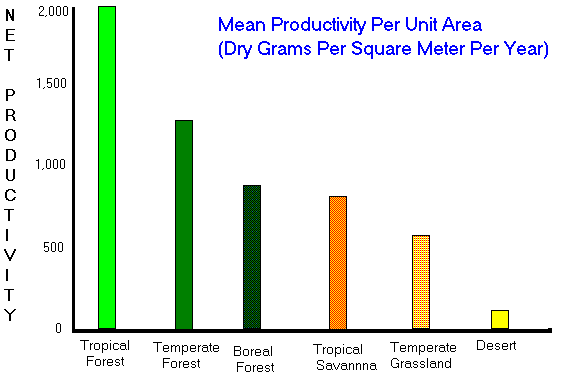
Image source: http://www.earthonlinemedia.com/ebooks/tpe_3e/biogeography/biomass_productivity.html.
More than two thirds (67.18%) of the terrestrial annual net primary productivity (~biomass production; NPP) come from forests of the world, amazingly, more than half of this originate from forests in the tropics (34% out of the 67.18%). What is even more fascinating is that it is able to have such huge productivity despite the fact that tropical forests cover only around 17 million km2, or roughly around 11.7% of the Earth’s land surface. Strictly speaking, excluding montane forest ecosystems, tropical rainforests cover roughly around 7% of Earth’s land surface - around 10.15 million km2. Assuming equal productivities between tropical rainforests and montane forest ecosystems, tropical rainforests have an annual NPP rate of around 22.09% - more than any of the estimated respective output of other terrestrial ecosystems (Whittaker, 1975; Osborne, 2012).
RAIN forest
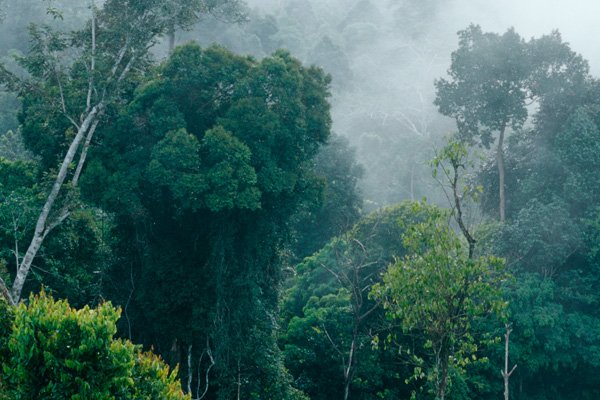
Image source: https://theos.in (© Mark Godfrey/TNC)
Rainforests, at the very least, have very limited seasonal dry season. Many rainforests do not experience water shortage, and have high relative humidity. Rainforests generally experience a precipitation of over 2,000mm annually which in turn helps keep the relative humidity at an average level of 80%. However, due to the pre-dominant level of solar energy, most rainforest have warm temperature, at a temperature average range of 25-35 degrees C (Schimper, 1903). As a result, the diurnal variations (~change in environmental conditions during the day; day vs night) play a more important influence in the living conditions and adaptability of the organisms living in rainforests as compared to the influence of seasonal variations (~in the tropics, the two seasons are: wet season and dry season) that can be observed in other ecosystems. The combination of these factors, makes a stable environmental condition that allows the rainforest to support a huge number of population as well as a set an ideal foreground for speciation as time goes by. As a result, most tropical rainforests are very diverse, with some few exceptions (Osborne, 2012).
Nutrient cycling and soil structure
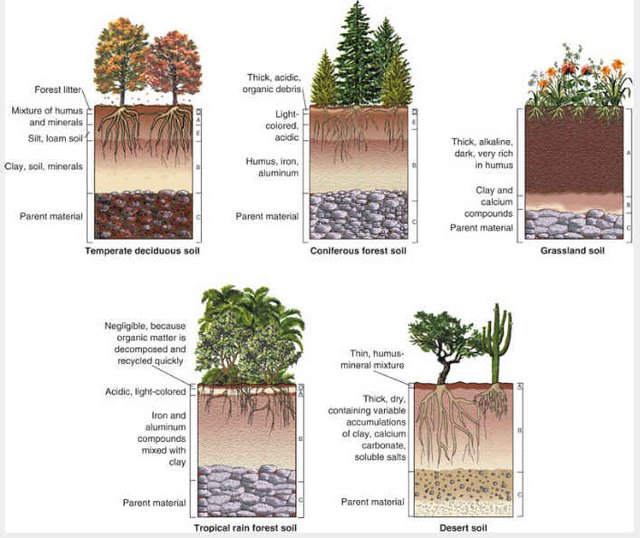
General comparison of tropical rainforest soil profile to other ecosystems (source: www.geo.hunter.cuny.edu).
Unlike other terrestrial ecosystems, the relative favorable environmental conditions of tropical rainforests promotes rapid break-down and decomposition of organic matter by shredders and decomposers. This rapid turnover of nutrients and high number of precipitation incidence in rainforests account for the high leaching rate of nutrients and minerals in the soil. Most of the leached nutrients and minerals are taken up by trees and other plants’ extensive root network, but some of inevitably escapes and are leached in stream and river networks, along with other sediments. As a result, the soil of tropical rainforests is highly leached, acidic and nutrient-poor, with very thin humus profile on its topsoil layer (Osborne, 2012).
Light as limiting factor
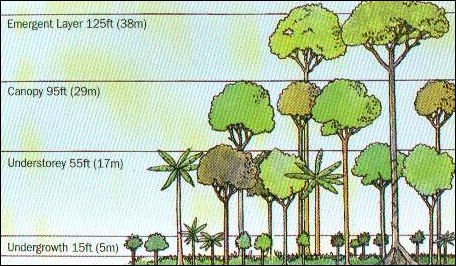
The strata of rainforests (Image source: http://factsanddetails.com/world/cat52/sub329/item1309.html).
Considering the high average annual daily solar radiation and its comparatively limited daily and seasonal fluctuations, solar energy is no doubt plentiful in the tropics (List, 1971). The solar radiation being received by a typical rainforest is high enough to the point that leaves exposed to direct sunlight may heat up significantly more than the prevailing air temperature and have large moisture saturation deficits despite the high relative humidity that rainforest typically have (Whitmore, 1993). However, due to the thick vegetation, solar energy might actually be a limiting factor for floral production in rainforests, especially for plants that grow beneath the main canopy line. This apparent competition for sunlight can be observed through the tree canopy layers and their shapes. The highest layer, formed by tall trees known as emergents (5-50m high), is a discontinuous canopy that is composed of crowns that are wide (diameter often more than 20m). The middle layer known as the ‘roof’, formed by middle-storey trees (25-35m high), is a continuous canopy that is composed of crowns that is smaller and more rounded, but they have adventitious branches that extend into available spaces. The bottom layer, formed by trees of varying heights from 10-15m, is a densely packed canopy that is composed of crowns that have varying shapes and have structural shapes that enables them to take utilize any sunlight available, and take advantage of the generally low light conditions. Beneath the tree layers are the shrub and herb layers that are composed of plants usually adapted to shade and moist conditions (Osborne, 2012).
Importance of Gaps
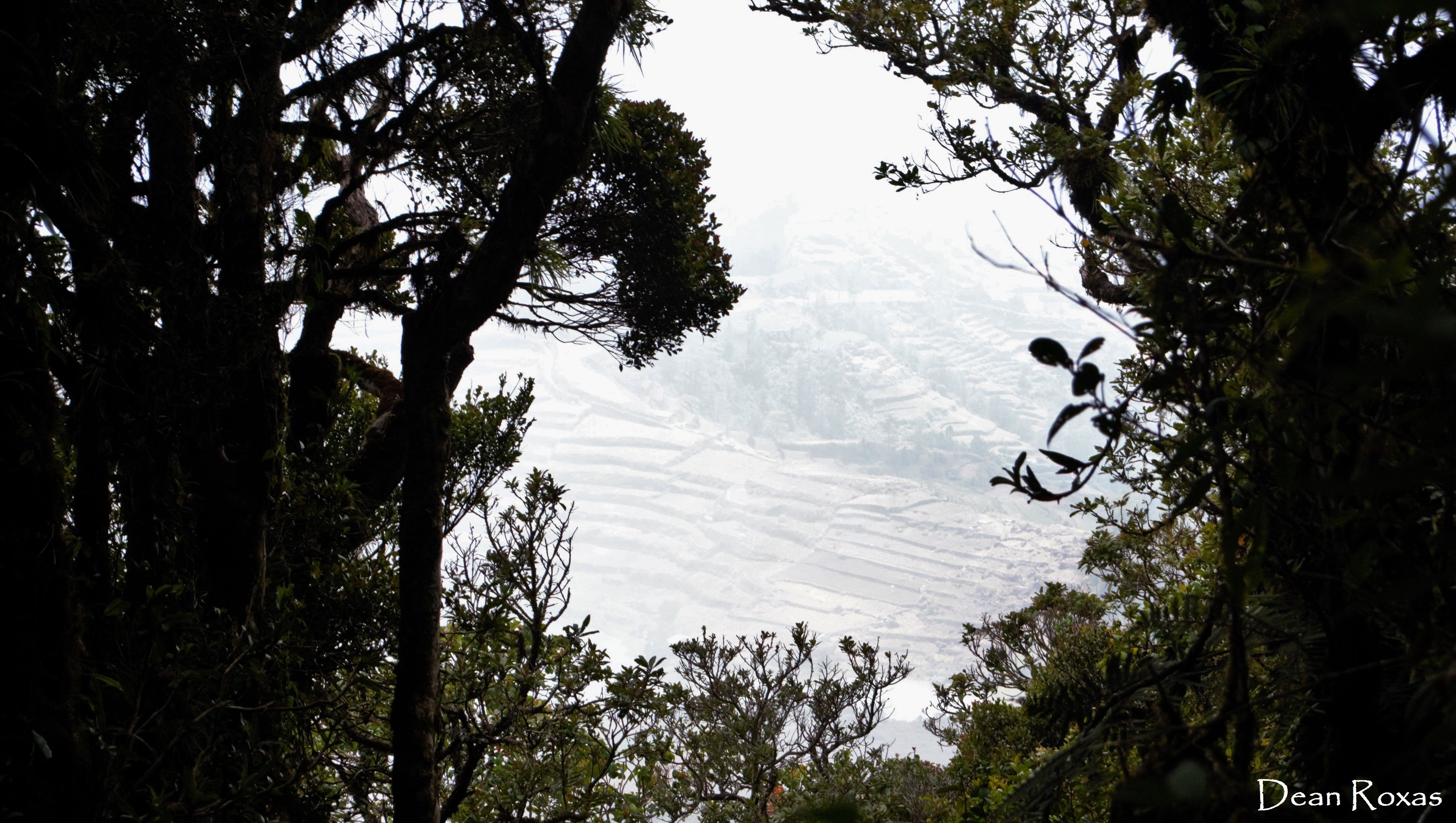
A gap in Mt. Tabayoc's Montane Rainforest (photo taken by me).
I have briefly discussed the importance of gaps in forests, but this is a more detailed explanation.^^ Heterogeneity is mainly enhanced when gaps in the rainforest canopy is produced. Some examples of natural events that realize such occurrence are storms, earthquake, lightning strikes, fire, timber fall or branch fall due to old age, and pest attack. By having such gaps, solar radiation can penetrate through and reach the forest floor. In turn, soil temperature, air temperature and even the localized evaporation rate and relative humidity would become higher for a time, and then would steadily decrease thereafter. Such changes would give other specialized plants to dominate and fill such gaps (e.g. grasses and pioneer tree species), and in turn increase primary production until the time when the forest canopy recovers. These gaps are essential not only in promoting heterogeneity, but also help produce new biomass and nutrients essential for the enhancement nutrient cycling in the rainforests (Osborne, 2012).
Deforestation and other human impacts
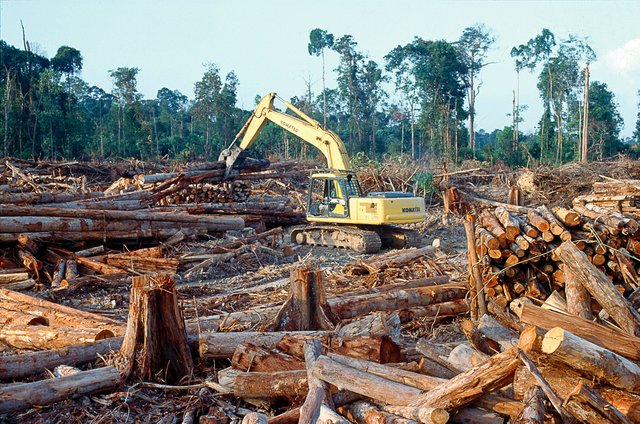
Image source: https://www.flickr.com/photos/rainforestactionnetwork/sets/72157626632532618/.
Anthropogenic change (~change caused by humans) is largely the culprit in abrupt ecological change and deterioration of rainforests. Large swaths of tropical rainforests have already been lost due deforestation, estimated at around 8 to 12 million km2 (Botkin and Keller, 2011; Wright and Muller-Landau, 2006). On average, the area of tropical rainforest loss during the 1990s was around 50,000 to 120,000 km2 per year; at the following rates in the following regions: 0.38%/year in Latin America, 0.43%/year in Africa and 0.91% in South-East Asia (Fearnside and Barbosa, 2004; Rodrigues et al., 2009; Achard et al., 2002).
Deforestation occurs for a variety of reasons. Logging for timber to be used as fuel, and for other uses such as paper manufacturing and use of wood in other products remain one of the key drivers for the logging industry to continue. Deforestation of many rainforests are also caused by the demand of land space for other uses; especially that of agriculture, pasture, and even human settlements. Such change in land use could have a large enough impact wherein tree growth could be hindered, and the establishment of secondary forests would not occur even if the area is left alone. As a result, many of the deforested areas inadvertently are converted into other types of ecosystem at best, most commonly into grasslands where tree growth and succession may be suppressed by many factors such as the seasonal occurrence of fires (Osborne, 2012).
References:
Achard, F. Eva, H.D., Stibig, H.-J., Mayaux, P., Gallego, J., Richards, T., Malingreau, J.-P. (2002). Determination of deforestation rates of the world's humid tropical forests. Science 297: 999-1002.
Blake, J.G. (2007). Neotropical forest bird communities: a comparison of species richness and composition at local and regional scales. Condor 109: 237-255.
Botkin, D.B. and Keller, E.A. (2011). Environmental science: Earth as a living planet. 8th edn. Hoboken, NJ: John Wiley & Sons, Inc.
Cardinale, B.J., Duffy, J.E., Gonzalez, A., Hooper, D.U., Perrings, C., Venail, P., Narwani, A., Mace, G.M., Tilman, D., Wardle, D.A., Kinzig, A.P., Daily, G.C., Loreau, M., Grace, J.B., Larigauderie, A., Srivastava, D.S., and Naeem, S. (2012). Biodiversity loss and its impact on humanity. Nature 486: 59-67.
Fearnside, P.M. and Barbosa, K.I. (2004). Accelerating deforestation in Brazilian Amazonia: towards answering open questions. Environmental Conservation 11: 7-10.
Gentry, A.H. (1988). Tree species richness of upper Amazonian forests. Proceedings of the National Academy of Sciences USA 85: 156-159.
List, R.J. (1971). Smithsonian meteorological tables. 6th edn. Washington DC: Smithsonian Institution Press.
Osborne, P.L. (2012). Tropical ecosystems and ecological concepts. 2nd edn. New York: Cambridge University Press.
Rodrigues, A.S.L., Ewers, R.M., Parry, L., Souza Jr., C., Verissimo, A., Balmford, A. (2009). Boom-and-bust development patterns across the Amazon deforestation frontier. Science 324: 1435-1437.
Schimper, A.F.W. (1903). Plant-geography upon a physiological basis. Oxford: Clarendon.
Stork, N.E. (2007). World of insects. Nature 448: 657-658.
Whitmore, T.C. (1993). An introduction to tropical rain forests. Oxford: Clarendon Press.
Whittaker, R.H. (1975). Communities and ecosystems. 2nd edn. London: Macmillan.
Wright, S.J. and Muller-Landau, H.C. (2006). The future of tropical forest species. Biotropica 38: 287-301.


This is a quality content that deserves a lot of attention. Am I reading a book? Congrats friend!
Book talaga? Haha. It's a short (modified) synthesis.😅😇
@originalworks
The @OriginalWorks bot has determined this post by @dean101 to be original material and upvoted it!
To call @OriginalWorks, simply reply to any post with @originalworks or !originalworks in your message!
To enter this post into the daily RESTEEM contest, upvote this comment! The user with the most upvotes on their @OriginalWorks comment will win!
For more information, Click Here! || Click here to participate in the @OriginalWorks writing contest!
Special thanks to @reggaemuffin for being a supporter! Vote him as a witness to help make Steemit a better place!
Congratulations! This post has been upvoted from the communal account, @minnowsupport, by dean101 from the Minnow Support Project. It's a witness project run by aggroed, ausbitbank, teamsteem, theprophet0, someguy123, neoxian, followbtcnews/crimsonclad, and netuoso. The goal is to help Steemit grow by supporting Minnows and creating a social network. Please find us in the Peace, Abundance, and Liberty Network (PALnet) Discord Channel. It's a completely public and open space to all members of the Steemit community who voluntarily choose to be there.
@cryptohustlin has voted on behalf of @minnowpond. If you would like to recieve upvotes from minnowpond on all your posts, simply FOLLOW @minnowpond. To be Resteemed to 4k+ followers and upvoted heavier send 0.25SBD to @minnowpond with your posts url as the memo
As a follower of @followforupvotes this post has been randomly selected and upvoted! Enjoy your upvote and have a great day!
Thanks! :>
@mrainp420 has voted on behalf of @minnowpond. If you would like to recieve upvotes from minnowpond on all your posts, simply FOLLOW @minnowpond. To be Resteemed to 4k+ followers and upvoted heavier send 0.25SBD to @minnowpond with your posts url as the memo
Resteemed to over 4900 followers and 100% upvoted. Thank you for using my service!
Read here how the new bot from Berlin works.
@resteem.bot
Thanks. :>
@minnowpond1 has voted on behalf of @minnowpond. If you would like to recieve upvotes from minnowpond on all your posts, simply FOLLOW @minnowpond. To be Resteemed to 4k+ followers and upvoted heavier send 0.25SBD to @minnowpond with your posts url as the memo
This post has received a 2.21 % upvote from @buildawhale thanks to: @dean101. Send at least 0.50 SBD to @buildawhale with a post link in the memo field for a portion of the next vote.
To support our curation initiative, please vote on my owner, @themarkymark, as a Steem Witness
This wonderful post has received a bellyrub 1.24 % upvote from @bellyrub thanks to this cool cat: @dean101. My pops @zeartul is one of your top steemit witness, if you like my bellyrubs please go vote for him, if you love what he is doing vote for this comment as well.